Organisational Behaviour: Motivation, Culture and Politics at ASDA
VerifiedAdded on 2022/12/27
|17
|5677
|77
Report
AI Summary
This report examines organisational behaviour within the context of ASDA, a British supermarket chain. It analyzes how organisational culture, politics, and power influence individual and team behaviour and performance. The report delves into the impact of power dynamics, including coercive, legitimate, reward, expert, referent, and informational power. It further explores how organisational politics and culture, as defined by Handy's culture typology, affect the workforce. Furthermore, the report evaluates content and process theories of motivation, such as Maslow's hierarchy of needs and Herzberg's two-factor theory, and how these theories enable effective goal achievement. The report also addresses the significance of effective team dynamics and development theories. Finally, the report provides an overview of the concepts and philosophies of organisational behaviour and how they influence behaviour in a given business situation.
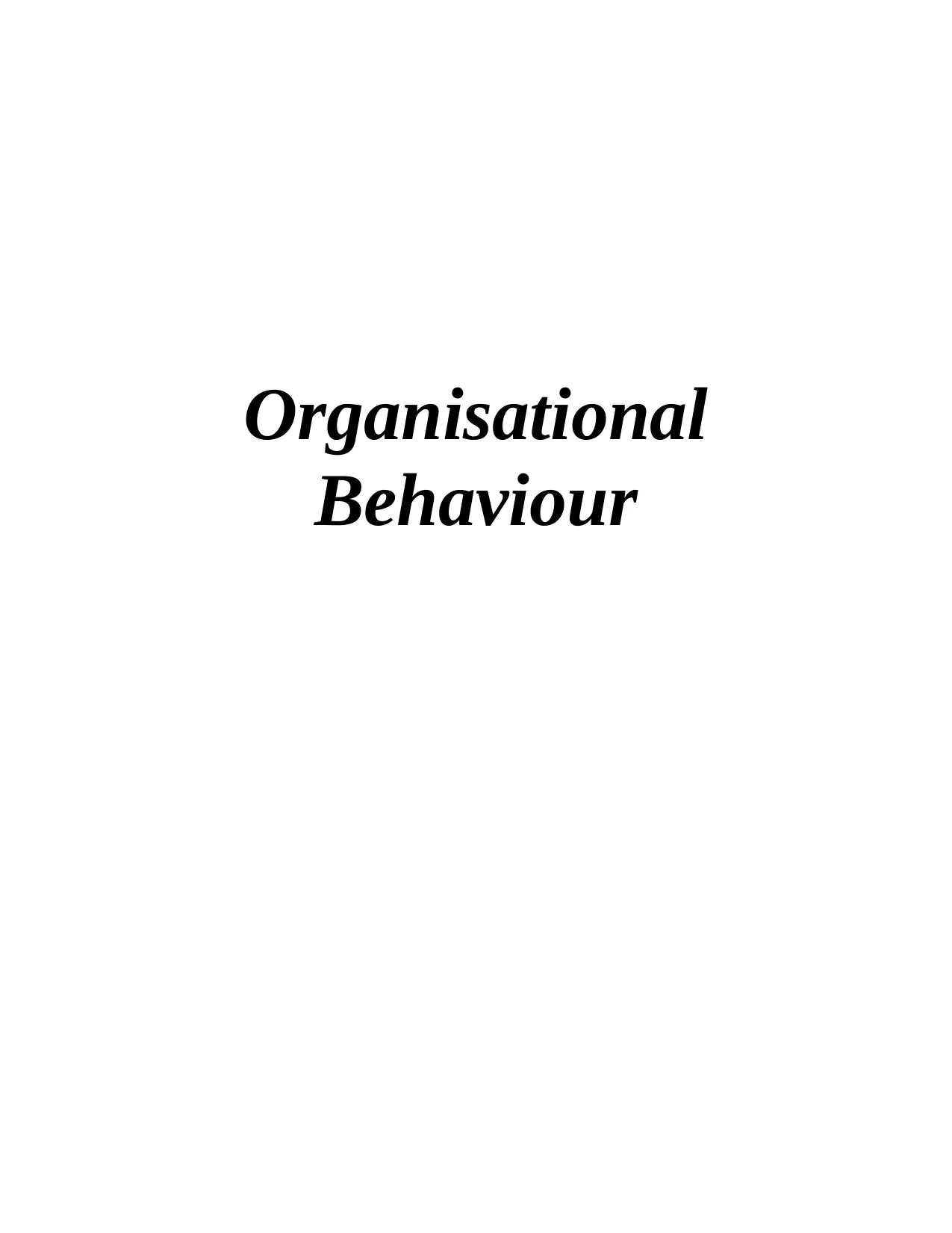
Organisational
Behaviour
Behaviour
Paraphrase This Document
Need a fresh take? Get an instant paraphrase of this document with our AI Paraphraser
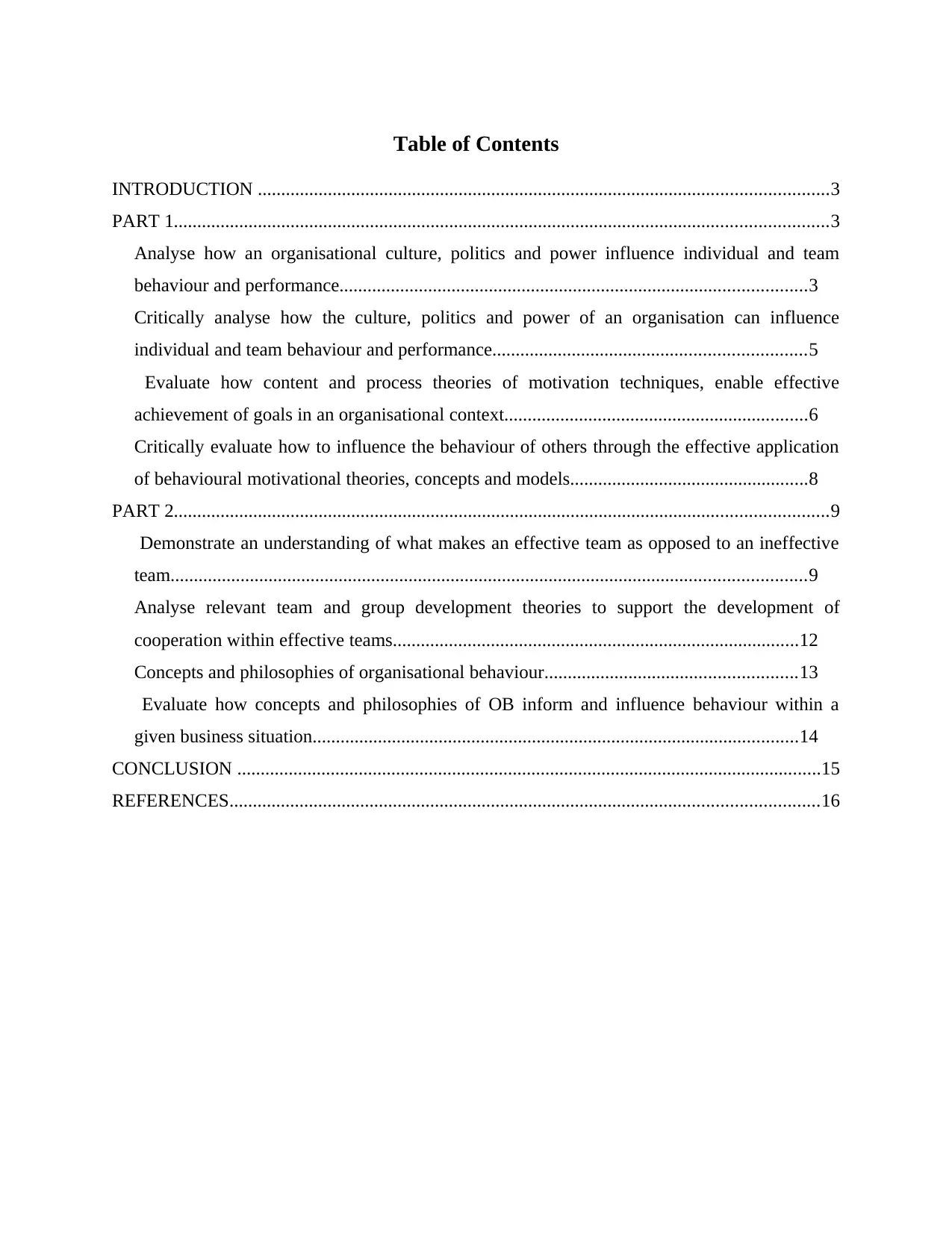
Table of Contents
INTRODUCTION ..........................................................................................................................3
PART 1............................................................................................................................................3
Analyse how an organisational culture, politics and power influence individual and team
behaviour and performance....................................................................................................3
Critically analyse how the culture, politics and power of an organisation can influence
individual and team behaviour and performance...................................................................5
Evaluate how content and process theories of motivation techniques, enable effective
achievement of goals in an organisational context.................................................................6
Critically evaluate how to influence the behaviour of others through the effective application
of behavioural motivational theories, concepts and models...................................................8
PART 2............................................................................................................................................9
Demonstrate an understanding of what makes an effective team as opposed to an ineffective
team........................................................................................................................................9
Analyse relevant team and group development theories to support the development of
cooperation within effective teams.......................................................................................12
Concepts and philosophies of organisational behaviour......................................................13
Evaluate how concepts and philosophies of OB inform and influence behaviour within a
given business situation........................................................................................................14
CONCLUSION .............................................................................................................................15
REFERENCES..............................................................................................................................16
INTRODUCTION ..........................................................................................................................3
PART 1............................................................................................................................................3
Analyse how an organisational culture, politics and power influence individual and team
behaviour and performance....................................................................................................3
Critically analyse how the culture, politics and power of an organisation can influence
individual and team behaviour and performance...................................................................5
Evaluate how content and process theories of motivation techniques, enable effective
achievement of goals in an organisational context.................................................................6
Critically evaluate how to influence the behaviour of others through the effective application
of behavioural motivational theories, concepts and models...................................................8
PART 2............................................................................................................................................9
Demonstrate an understanding of what makes an effective team as opposed to an ineffective
team........................................................................................................................................9
Analyse relevant team and group development theories to support the development of
cooperation within effective teams.......................................................................................12
Concepts and philosophies of organisational behaviour......................................................13
Evaluate how concepts and philosophies of OB inform and influence behaviour within a
given business situation........................................................................................................14
CONCLUSION .............................................................................................................................15
REFERENCES..............................................................................................................................16
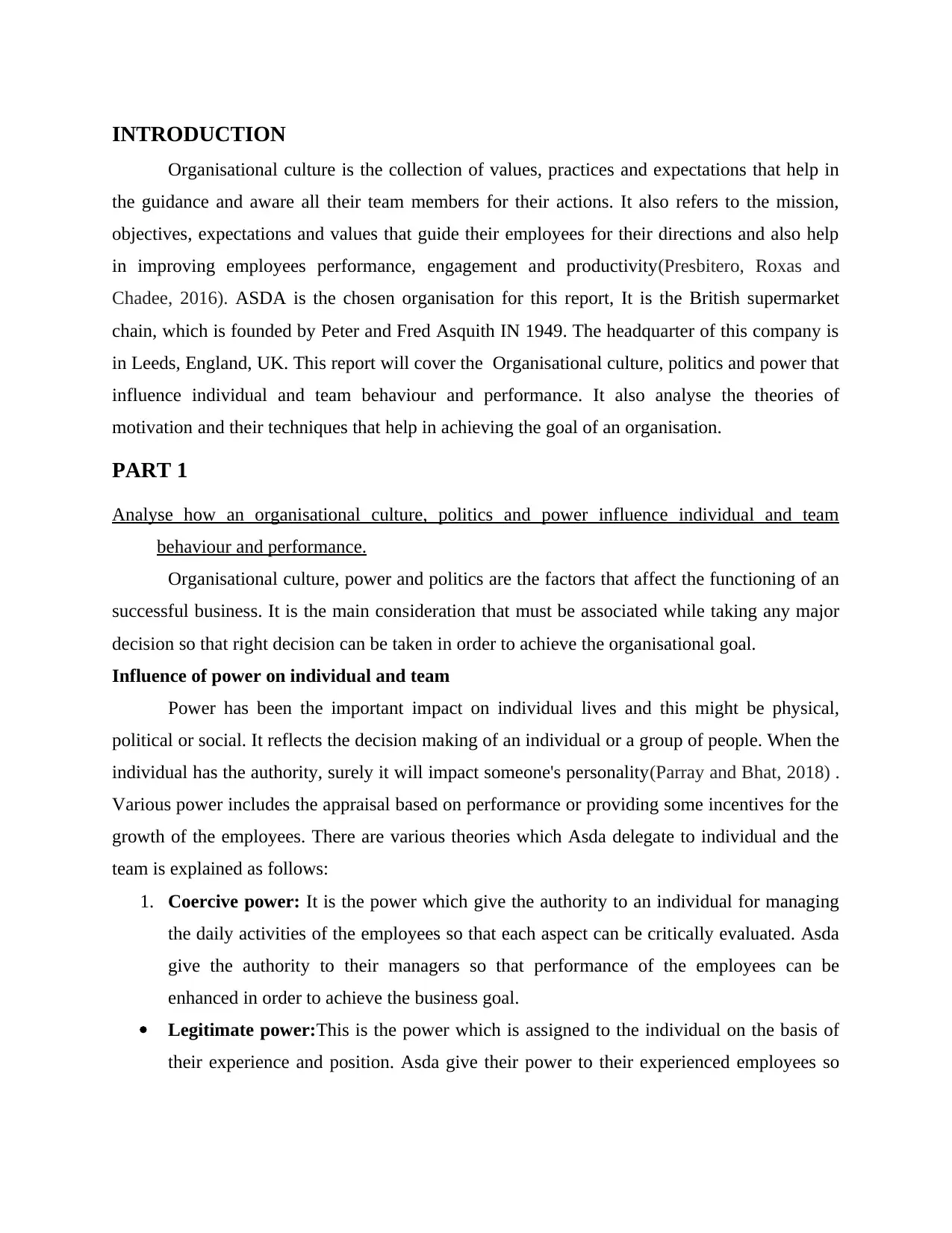
INTRODUCTION
Organisational culture is the collection of values, practices and expectations that help in
the guidance and aware all their team members for their actions. It also refers to the mission,
objectives, expectations and values that guide their employees for their directions and also help
in improving employees performance, engagement and productivity(Presbitero, Roxas and
Chadee, 2016). ASDA is the chosen organisation for this report, It is the British supermarket
chain, which is founded by Peter and Fred Asquith IN 1949. The headquarter of this company is
in Leeds, England, UK. This report will cover the Organisational culture, politics and power that
influence individual and team behaviour and performance. It also analyse the theories of
motivation and their techniques that help in achieving the goal of an organisation.
PART 1
Analyse how an organisational culture, politics and power influence individual and team
behaviour and performance.
Organisational culture, power and politics are the factors that affect the functioning of an
successful business. It is the main consideration that must be associated while taking any major
decision so that right decision can be taken in order to achieve the organisational goal.
Influence of power on individual and team
Power has been the important impact on individual lives and this might be physical,
political or social. It reflects the decision making of an individual or a group of people. When the
individual has the authority, surely it will impact someone's personality(Parray and Bhat, 2018) .
Various power includes the appraisal based on performance or providing some incentives for the
growth of the employees. There are various theories which Asda delegate to individual and the
team is explained as follows:
1. Coercive power: It is the power which give the authority to an individual for managing
the daily activities of the employees so that each aspect can be critically evaluated. Asda
give the authority to their managers so that performance of the employees can be
enhanced in order to achieve the business goal.
Legitimate power:This is the power which is assigned to the individual on the basis of
their experience and position. Asda give their power to their experienced employees so
Organisational culture is the collection of values, practices and expectations that help in
the guidance and aware all their team members for their actions. It also refers to the mission,
objectives, expectations and values that guide their employees for their directions and also help
in improving employees performance, engagement and productivity(Presbitero, Roxas and
Chadee, 2016). ASDA is the chosen organisation for this report, It is the British supermarket
chain, which is founded by Peter and Fred Asquith IN 1949. The headquarter of this company is
in Leeds, England, UK. This report will cover the Organisational culture, politics and power that
influence individual and team behaviour and performance. It also analyse the theories of
motivation and their techniques that help in achieving the goal of an organisation.
PART 1
Analyse how an organisational culture, politics and power influence individual and team
behaviour and performance.
Organisational culture, power and politics are the factors that affect the functioning of an
successful business. It is the main consideration that must be associated while taking any major
decision so that right decision can be taken in order to achieve the organisational goal.
Influence of power on individual and team
Power has been the important impact on individual lives and this might be physical,
political or social. It reflects the decision making of an individual or a group of people. When the
individual has the authority, surely it will impact someone's personality(Parray and Bhat, 2018) .
Various power includes the appraisal based on performance or providing some incentives for the
growth of the employees. There are various theories which Asda delegate to individual and the
team is explained as follows:
1. Coercive power: It is the power which give the authority to an individual for managing
the daily activities of the employees so that each aspect can be critically evaluated. Asda
give the authority to their managers so that performance of the employees can be
enhanced in order to achieve the business goal.
Legitimate power:This is the power which is assigned to the individual on the basis of
their experience and position. Asda give their power to their experienced employees so
⊘ This is a preview!⊘
Do you want full access?
Subscribe today to unlock all pages.

Trusted by 1+ million students worldwide
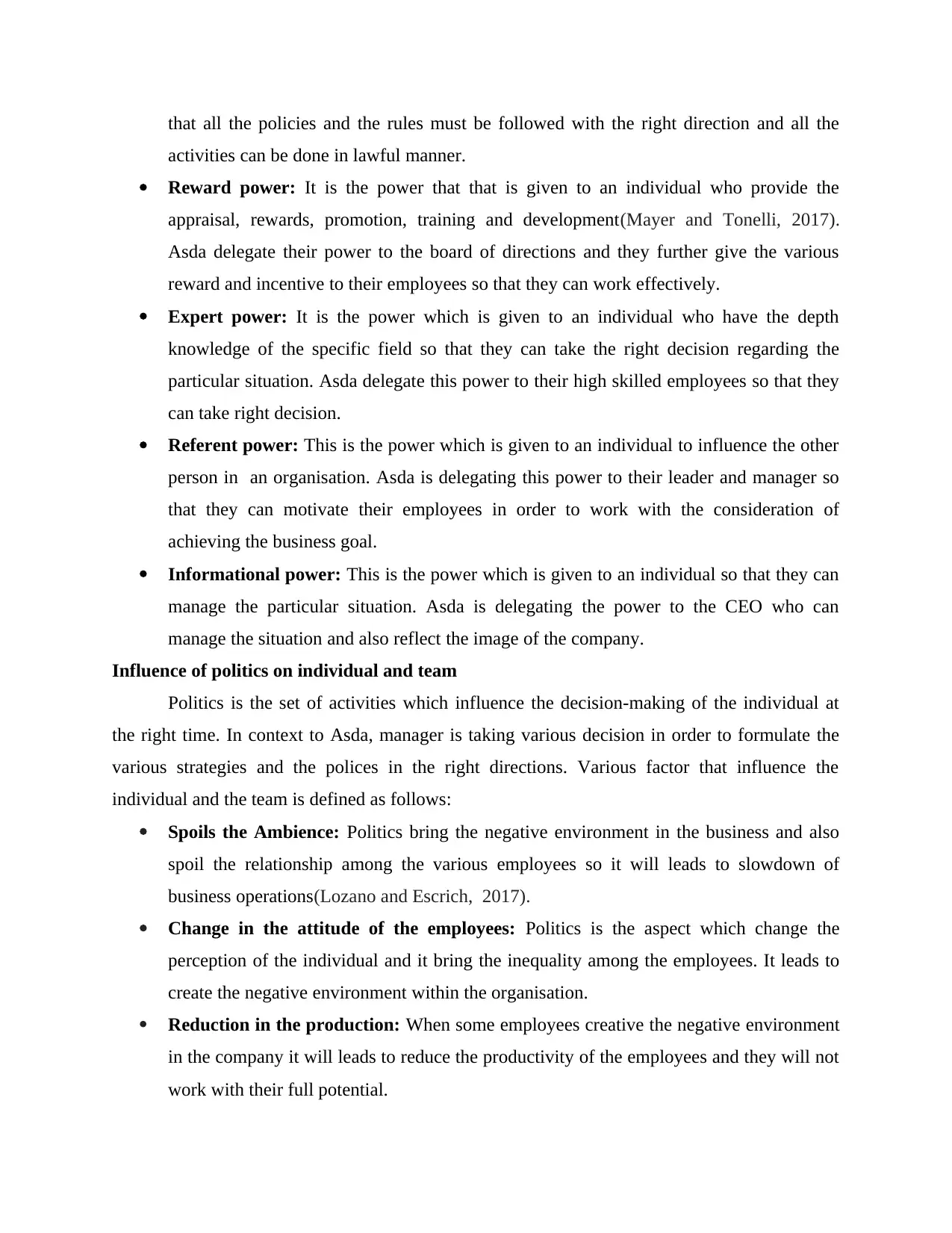
that all the policies and the rules must be followed with the right direction and all the
activities can be done in lawful manner.
Reward power: It is the power that that is given to an individual who provide the
appraisal, rewards, promotion, training and development(Mayer and Tonelli, 2017).
Asda delegate their power to the board of directions and they further give the various
reward and incentive to their employees so that they can work effectively.
Expert power: It is the power which is given to an individual who have the depth
knowledge of the specific field so that they can take the right decision regarding the
particular situation. Asda delegate this power to their high skilled employees so that they
can take right decision.
Referent power: This is the power which is given to an individual to influence the other
person in an organisation. Asda is delegating this power to their leader and manager so
that they can motivate their employees in order to work with the consideration of
achieving the business goal.
Informational power: This is the power which is given to an individual so that they can
manage the particular situation. Asda is delegating the power to the CEO who can
manage the situation and also reflect the image of the company.
Influence of politics on individual and team
Politics is the set of activities which influence the decision-making of the individual at
the right time. In context to Asda, manager is taking various decision in order to formulate the
various strategies and the polices in the right directions. Various factor that influence the
individual and the team is defined as follows:
Spoils the Ambience: Politics bring the negative environment in the business and also
spoil the relationship among the various employees so it will leads to slowdown of
business operations(Lozano and Escrich, 2017).
Change in the attitude of the employees: Politics is the aspect which change the
perception of the individual and it bring the inequality among the employees. It leads to
create the negative environment within the organisation.
Reduction in the production: When some employees creative the negative environment
in the company it will leads to reduce the productivity of the employees and they will not
work with their full potential.
activities can be done in lawful manner.
Reward power: It is the power that that is given to an individual who provide the
appraisal, rewards, promotion, training and development(Mayer and Tonelli, 2017).
Asda delegate their power to the board of directions and they further give the various
reward and incentive to their employees so that they can work effectively.
Expert power: It is the power which is given to an individual who have the depth
knowledge of the specific field so that they can take the right decision regarding the
particular situation. Asda delegate this power to their high skilled employees so that they
can take right decision.
Referent power: This is the power which is given to an individual to influence the other
person in an organisation. Asda is delegating this power to their leader and manager so
that they can motivate their employees in order to work with the consideration of
achieving the business goal.
Informational power: This is the power which is given to an individual so that they can
manage the particular situation. Asda is delegating the power to the CEO who can
manage the situation and also reflect the image of the company.
Influence of politics on individual and team
Politics is the set of activities which influence the decision-making of the individual at
the right time. In context to Asda, manager is taking various decision in order to formulate the
various strategies and the polices in the right directions. Various factor that influence the
individual and the team is defined as follows:
Spoils the Ambience: Politics bring the negative environment in the business and also
spoil the relationship among the various employees so it will leads to slowdown of
business operations(Lozano and Escrich, 2017).
Change in the attitude of the employees: Politics is the aspect which change the
perception of the individual and it bring the inequality among the employees. It leads to
create the negative environment within the organisation.
Reduction in the production: When some employees creative the negative environment
in the company it will leads to reduce the productivity of the employees and they will not
work with their full potential.
Paraphrase This Document
Need a fresh take? Get an instant paraphrase of this document with our AI Paraphraser
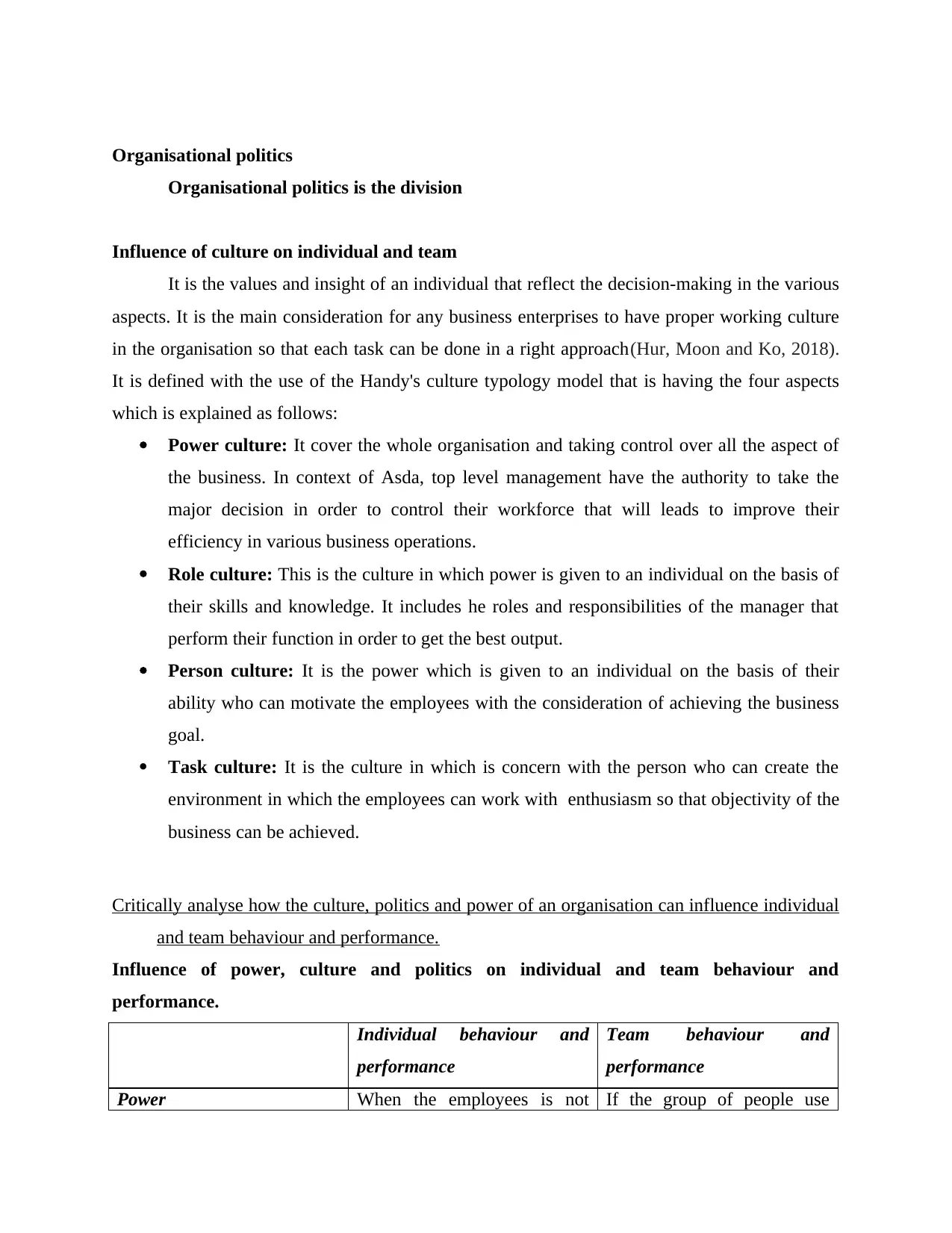
Organisational politics
Organisational politics is the division
Influence of culture on individual and team
It is the values and insight of an individual that reflect the decision-making in the various
aspects. It is the main consideration for any business enterprises to have proper working culture
in the organisation so that each task can be done in a right approach(Hur, Moon and Ko, 2018).
It is defined with the use of the Handy's culture typology model that is having the four aspects
which is explained as follows:
Power culture: It cover the whole organisation and taking control over all the aspect of
the business. In context of Asda, top level management have the authority to take the
major decision in order to control their workforce that will leads to improve their
efficiency in various business operations.
Role culture: This is the culture in which power is given to an individual on the basis of
their skills and knowledge. It includes he roles and responsibilities of the manager that
perform their function in order to get the best output.
Person culture: It is the power which is given to an individual on the basis of their
ability who can motivate the employees with the consideration of achieving the business
goal.
Task culture: It is the culture in which is concern with the person who can create the
environment in which the employees can work with enthusiasm so that objectivity of the
business can be achieved.
Critically analyse how the culture, politics and power of an organisation can influence individual
and team behaviour and performance.
Influence of power, culture and politics on individual and team behaviour and
performance.
Individual behaviour and
performance
Team behaviour and
performance
Power When the employees is not If the group of people use
Organisational politics is the division
Influence of culture on individual and team
It is the values and insight of an individual that reflect the decision-making in the various
aspects. It is the main consideration for any business enterprises to have proper working culture
in the organisation so that each task can be done in a right approach(Hur, Moon and Ko, 2018).
It is defined with the use of the Handy's culture typology model that is having the four aspects
which is explained as follows:
Power culture: It cover the whole organisation and taking control over all the aspect of
the business. In context of Asda, top level management have the authority to take the
major decision in order to control their workforce that will leads to improve their
efficiency in various business operations.
Role culture: This is the culture in which power is given to an individual on the basis of
their skills and knowledge. It includes he roles and responsibilities of the manager that
perform their function in order to get the best output.
Person culture: It is the power which is given to an individual on the basis of their
ability who can motivate the employees with the consideration of achieving the business
goal.
Task culture: It is the culture in which is concern with the person who can create the
environment in which the employees can work with enthusiasm so that objectivity of the
business can be achieved.
Critically analyse how the culture, politics and power of an organisation can influence individual
and team behaviour and performance.
Influence of power, culture and politics on individual and team behaviour and
performance.
Individual behaviour and
performance
Team behaviour and
performance
Power When the employees is not If the group of people use
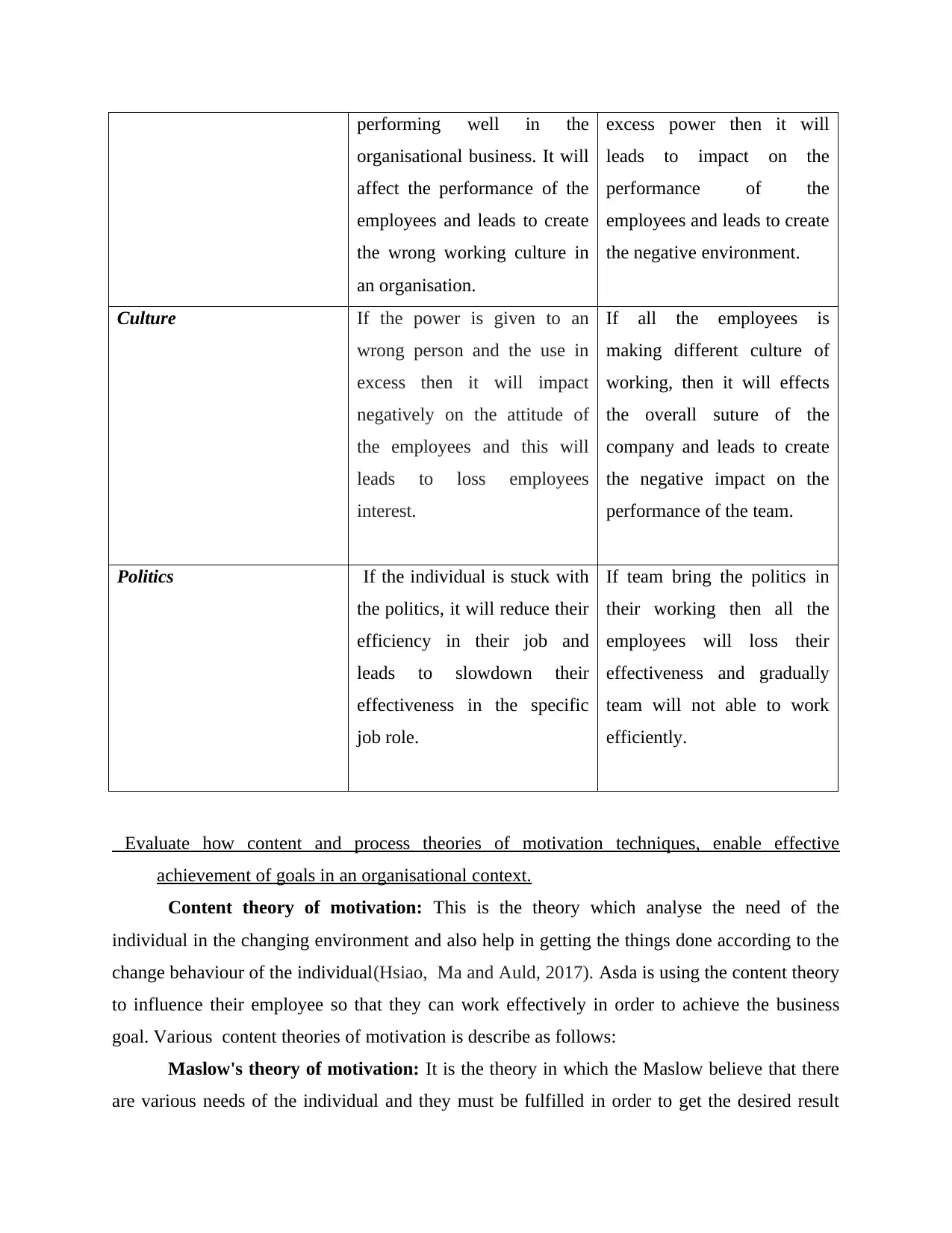
performing well in the
organisational business. It will
affect the performance of the
employees and leads to create
the wrong working culture in
an organisation.
excess power then it will
leads to impact on the
performance of the
employees and leads to create
the negative environment.
Culture If the power is given to an
wrong person and the use in
excess then it will impact
negatively on the attitude of
the employees and this will
leads to loss employees
interest.
If all the employees is
making different culture of
working, then it will effects
the overall suture of the
company and leads to create
the negative impact on the
performance of the team.
Politics If the individual is stuck with
the politics, it will reduce their
efficiency in their job and
leads to slowdown their
effectiveness in the specific
job role.
If team bring the politics in
their working then all the
employees will loss their
effectiveness and gradually
team will not able to work
efficiently.
Evaluate how content and process theories of motivation techniques, enable effective
achievement of goals in an organisational context.
Content theory of motivation: This is the theory which analyse the need of the
individual in the changing environment and also help in getting the things done according to the
change behaviour of the individual(Hsiao, Ma and Auld, 2017). Asda is using the content theory
to influence their employee so that they can work effectively in order to achieve the business
goal. Various content theories of motivation is describe as follows:
Maslow's theory of motivation: It is the theory in which the Maslow believe that there
are various needs of the individual and they must be fulfilled in order to get the desired result
organisational business. It will
affect the performance of the
employees and leads to create
the wrong working culture in
an organisation.
excess power then it will
leads to impact on the
performance of the
employees and leads to create
the negative environment.
Culture If the power is given to an
wrong person and the use in
excess then it will impact
negatively on the attitude of
the employees and this will
leads to loss employees
interest.
If all the employees is
making different culture of
working, then it will effects
the overall suture of the
company and leads to create
the negative impact on the
performance of the team.
Politics If the individual is stuck with
the politics, it will reduce their
efficiency in their job and
leads to slowdown their
effectiveness in the specific
job role.
If team bring the politics in
their working then all the
employees will loss their
effectiveness and gradually
team will not able to work
efficiently.
Evaluate how content and process theories of motivation techniques, enable effective
achievement of goals in an organisational context.
Content theory of motivation: This is the theory which analyse the need of the
individual in the changing environment and also help in getting the things done according to the
change behaviour of the individual(Hsiao, Ma and Auld, 2017). Asda is using the content theory
to influence their employee so that they can work effectively in order to achieve the business
goal. Various content theories of motivation is describe as follows:
Maslow's theory of motivation: It is the theory in which the Maslow believe that there
are various needs of the individual and they must be fulfilled in order to get the desired result
⊘ This is a preview!⊘
Do you want full access?
Subscribe today to unlock all pages.

Trusted by 1+ million students worldwide
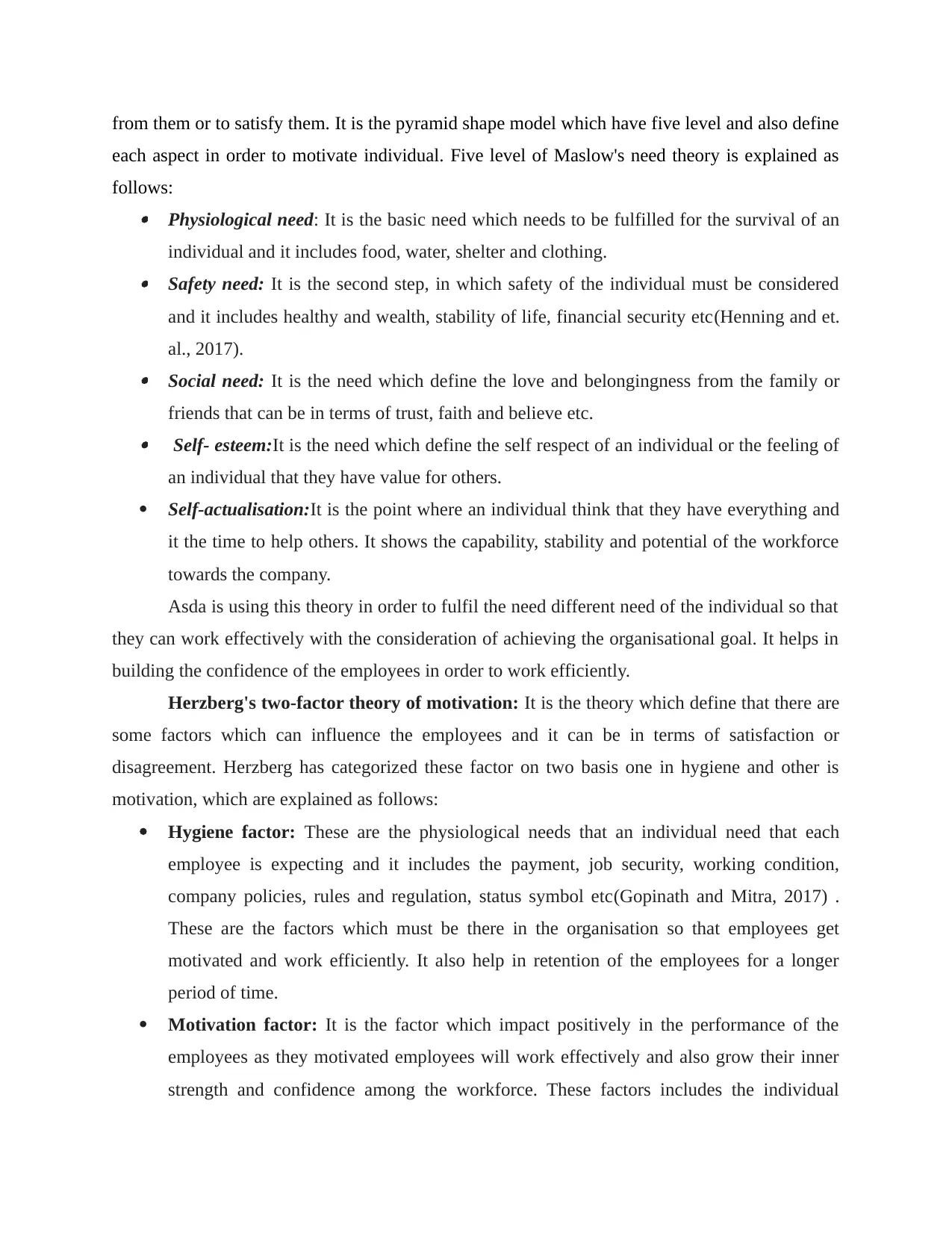
from them or to satisfy them. It is the pyramid shape model which have five level and also define
each aspect in order to motivate individual. Five level of Maslow's need theory is explained as
follows: Physiological need: It is the basic need which needs to be fulfilled for the survival of an
individual and it includes food, water, shelter and clothing. Safety need: It is the second step, in which safety of the individual must be considered
and it includes healthy and wealth, stability of life, financial security etc(Henning and et.
al., 2017). Social need: It is the need which define the love and belongingness from the family or
friends that can be in terms of trust, faith and believe etc. Self- esteem:It is the need which define the self respect of an individual or the feeling of
an individual that they have value for others.
Self-actualisation:It is the point where an individual think that they have everything and
it the time to help others. It shows the capability, stability and potential of the workforce
towards the company.
Asda is using this theory in order to fulfil the need different need of the individual so that
they can work effectively with the consideration of achieving the organisational goal. It helps in
building the confidence of the employees in order to work efficiently.
Herzberg's two-factor theory of motivation: It is the theory which define that there are
some factors which can influence the employees and it can be in terms of satisfaction or
disagreement. Herzberg has categorized these factor on two basis one in hygiene and other is
motivation, which are explained as follows:
Hygiene factor: These are the physiological needs that an individual need that each
employee is expecting and it includes the payment, job security, working condition,
company policies, rules and regulation, status symbol etc(Gopinath and Mitra, 2017) .
These are the factors which must be there in the organisation so that employees get
motivated and work efficiently. It also help in retention of the employees for a longer
period of time.
Motivation factor: It is the factor which impact positively in the performance of the
employees as they motivated employees will work effectively and also grow their inner
strength and confidence among the workforce. These factors includes the individual
each aspect in order to motivate individual. Five level of Maslow's need theory is explained as
follows: Physiological need: It is the basic need which needs to be fulfilled for the survival of an
individual and it includes food, water, shelter and clothing. Safety need: It is the second step, in which safety of the individual must be considered
and it includes healthy and wealth, stability of life, financial security etc(Henning and et.
al., 2017). Social need: It is the need which define the love and belongingness from the family or
friends that can be in terms of trust, faith and believe etc. Self- esteem:It is the need which define the self respect of an individual or the feeling of
an individual that they have value for others.
Self-actualisation:It is the point where an individual think that they have everything and
it the time to help others. It shows the capability, stability and potential of the workforce
towards the company.
Asda is using this theory in order to fulfil the need different need of the individual so that
they can work effectively with the consideration of achieving the organisational goal. It helps in
building the confidence of the employees in order to work efficiently.
Herzberg's two-factor theory of motivation: It is the theory which define that there are
some factors which can influence the employees and it can be in terms of satisfaction or
disagreement. Herzberg has categorized these factor on two basis one in hygiene and other is
motivation, which are explained as follows:
Hygiene factor: These are the physiological needs that an individual need that each
employee is expecting and it includes the payment, job security, working condition,
company policies, rules and regulation, status symbol etc(Gopinath and Mitra, 2017) .
These are the factors which must be there in the organisation so that employees get
motivated and work efficiently. It also help in retention of the employees for a longer
period of time.
Motivation factor: It is the factor which impact positively in the performance of the
employees as they motivated employees will work effectively and also grow their inner
strength and confidence among the workforce. These factors includes the individual
Paraphrase This Document
Need a fresh take? Get an instant paraphrase of this document with our AI Paraphraser
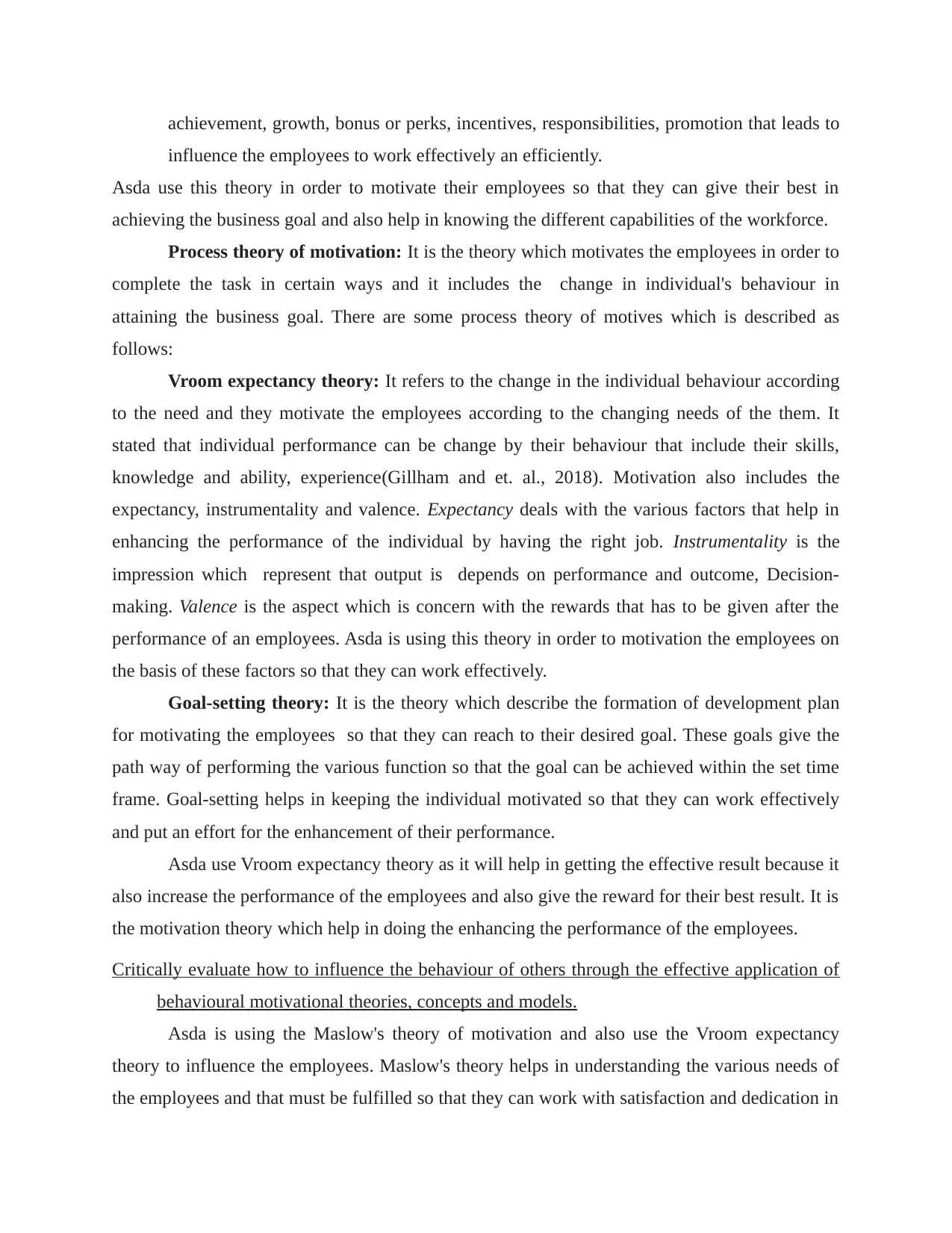
achievement, growth, bonus or perks, incentives, responsibilities, promotion that leads to
influence the employees to work effectively an efficiently.
Asda use this theory in order to motivate their employees so that they can give their best in
achieving the business goal and also help in knowing the different capabilities of the workforce.
Process theory of motivation: It is the theory which motivates the employees in order to
complete the task in certain ways and it includes the change in individual's behaviour in
attaining the business goal. There are some process theory of motives which is described as
follows:
Vroom expectancy theory: It refers to the change in the individual behaviour according
to the need and they motivate the employees according to the changing needs of the them. It
stated that individual performance can be change by their behaviour that include their skills,
knowledge and ability, experience(Gillham and et. al., 2018). Motivation also includes the
expectancy, instrumentality and valence. Expectancy deals with the various factors that help in
enhancing the performance of the individual by having the right job. Instrumentality is the
impression which represent that output is depends on performance and outcome, Decision-
making. Valence is the aspect which is concern with the rewards that has to be given after the
performance of an employees. Asda is using this theory in order to motivation the employees on
the basis of these factors so that they can work effectively.
Goal-setting theory: It is the theory which describe the formation of development plan
for motivating the employees so that they can reach to their desired goal. These goals give the
path way of performing the various function so that the goal can be achieved within the set time
frame. Goal-setting helps in keeping the individual motivated so that they can work effectively
and put an effort for the enhancement of their performance.
Asda use Vroom expectancy theory as it will help in getting the effective result because it
also increase the performance of the employees and also give the reward for their best result. It is
the motivation theory which help in doing the enhancing the performance of the employees.
Critically evaluate how to influence the behaviour of others through the effective application of
behavioural motivational theories, concepts and models.
Asda is using the Maslow's theory of motivation and also use the Vroom expectancy
theory to influence the employees. Maslow's theory helps in understanding the various needs of
the employees and that must be fulfilled so that they can work with satisfaction and dedication in
influence the employees to work effectively an efficiently.
Asda use this theory in order to motivate their employees so that they can give their best in
achieving the business goal and also help in knowing the different capabilities of the workforce.
Process theory of motivation: It is the theory which motivates the employees in order to
complete the task in certain ways and it includes the change in individual's behaviour in
attaining the business goal. There are some process theory of motives which is described as
follows:
Vroom expectancy theory: It refers to the change in the individual behaviour according
to the need and they motivate the employees according to the changing needs of the them. It
stated that individual performance can be change by their behaviour that include their skills,
knowledge and ability, experience(Gillham and et. al., 2018). Motivation also includes the
expectancy, instrumentality and valence. Expectancy deals with the various factors that help in
enhancing the performance of the individual by having the right job. Instrumentality is the
impression which represent that output is depends on performance and outcome, Decision-
making. Valence is the aspect which is concern with the rewards that has to be given after the
performance of an employees. Asda is using this theory in order to motivation the employees on
the basis of these factors so that they can work effectively.
Goal-setting theory: It is the theory which describe the formation of development plan
for motivating the employees so that they can reach to their desired goal. These goals give the
path way of performing the various function so that the goal can be achieved within the set time
frame. Goal-setting helps in keeping the individual motivated so that they can work effectively
and put an effort for the enhancement of their performance.
Asda use Vroom expectancy theory as it will help in getting the effective result because it
also increase the performance of the employees and also give the reward for their best result. It is
the motivation theory which help in doing the enhancing the performance of the employees.
Critically evaluate how to influence the behaviour of others through the effective application of
behavioural motivational theories, concepts and models.
Asda is using the Maslow's theory of motivation and also use the Vroom expectancy
theory to influence the employees. Maslow's theory helps in understanding the various needs of
the employees and that must be fulfilled so that they can work with satisfaction and dedication in
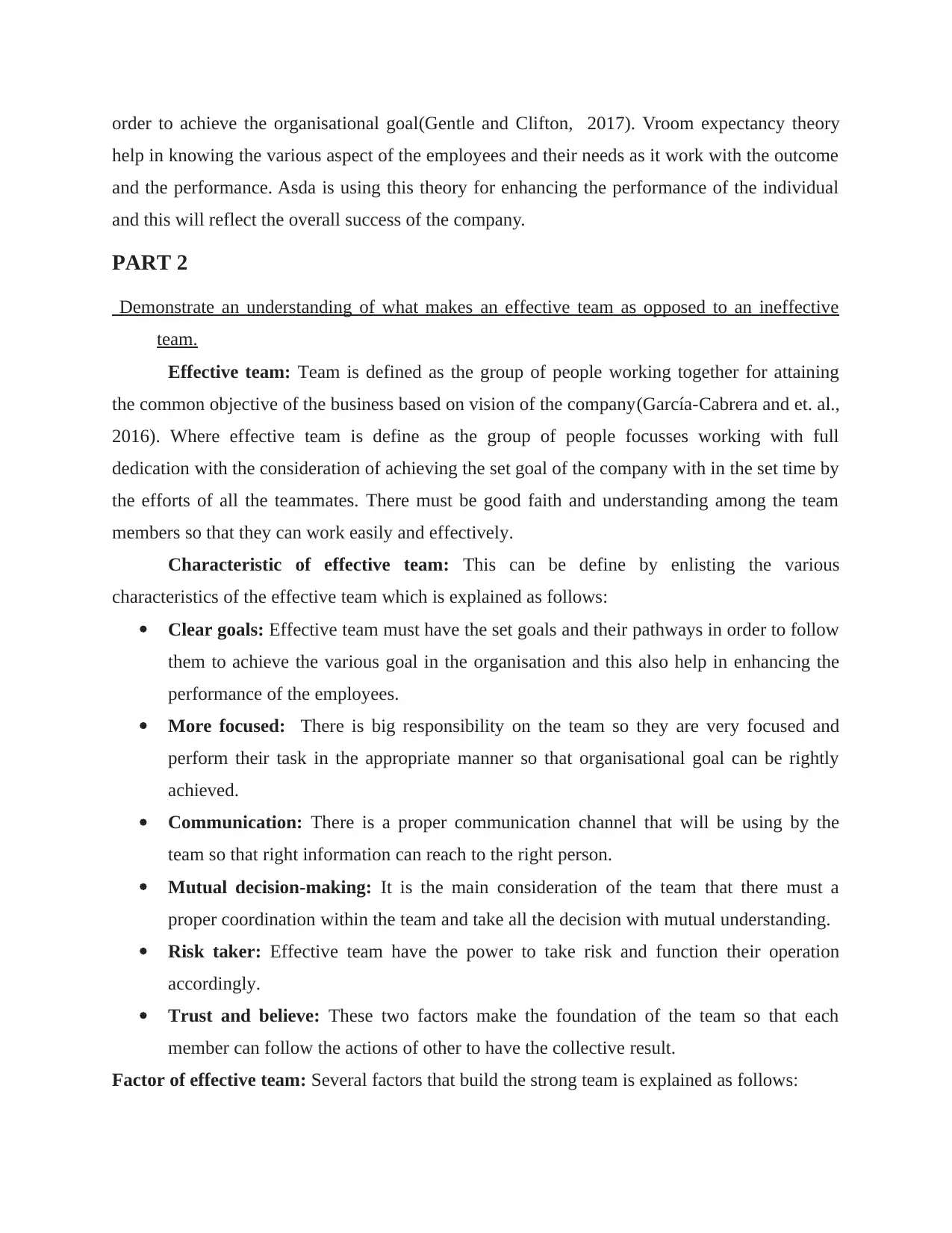
order to achieve the organisational goal(Gentle and Clifton, 2017). Vroom expectancy theory
help in knowing the various aspect of the employees and their needs as it work with the outcome
and the performance. Asda is using this theory for enhancing the performance of the individual
and this will reflect the overall success of the company.
PART 2
Demonstrate an understanding of what makes an effective team as opposed to an ineffective
team.
Effective team: Team is defined as the group of people working together for attaining
the common objective of the business based on vision of the company(García-Cabrera and et. al.,
2016). Where effective team is define as the group of people focusses working with full
dedication with the consideration of achieving the set goal of the company with in the set time by
the efforts of all the teammates. There must be good faith and understanding among the team
members so that they can work easily and effectively.
Characteristic of effective team: This can be define by enlisting the various
characteristics of the effective team which is explained as follows:
Clear goals: Effective team must have the set goals and their pathways in order to follow
them to achieve the various goal in the organisation and this also help in enhancing the
performance of the employees.
More focused: There is big responsibility on the team so they are very focused and
perform their task in the appropriate manner so that organisational goal can be rightly
achieved.
Communication: There is a proper communication channel that will be using by the
team so that right information can reach to the right person.
Mutual decision-making: It is the main consideration of the team that there must a
proper coordination within the team and take all the decision with mutual understanding.
Risk taker: Effective team have the power to take risk and function their operation
accordingly.
Trust and believe: These two factors make the foundation of the team so that each
member can follow the actions of other to have the collective result.
Factor of effective team: Several factors that build the strong team is explained as follows:
help in knowing the various aspect of the employees and their needs as it work with the outcome
and the performance. Asda is using this theory for enhancing the performance of the individual
and this will reflect the overall success of the company.
PART 2
Demonstrate an understanding of what makes an effective team as opposed to an ineffective
team.
Effective team: Team is defined as the group of people working together for attaining
the common objective of the business based on vision of the company(García-Cabrera and et. al.,
2016). Where effective team is define as the group of people focusses working with full
dedication with the consideration of achieving the set goal of the company with in the set time by
the efforts of all the teammates. There must be good faith and understanding among the team
members so that they can work easily and effectively.
Characteristic of effective team: This can be define by enlisting the various
characteristics of the effective team which is explained as follows:
Clear goals: Effective team must have the set goals and their pathways in order to follow
them to achieve the various goal in the organisation and this also help in enhancing the
performance of the employees.
More focused: There is big responsibility on the team so they are very focused and
perform their task in the appropriate manner so that organisational goal can be rightly
achieved.
Communication: There is a proper communication channel that will be using by the
team so that right information can reach to the right person.
Mutual decision-making: It is the main consideration of the team that there must a
proper coordination within the team and take all the decision with mutual understanding.
Risk taker: Effective team have the power to take risk and function their operation
accordingly.
Trust and believe: These two factors make the foundation of the team so that each
member can follow the actions of other to have the collective result.
Factor of effective team: Several factors that build the strong team is explained as follows:
⊘ This is a preview!⊘
Do you want full access?
Subscribe today to unlock all pages.

Trusted by 1+ million students worldwide
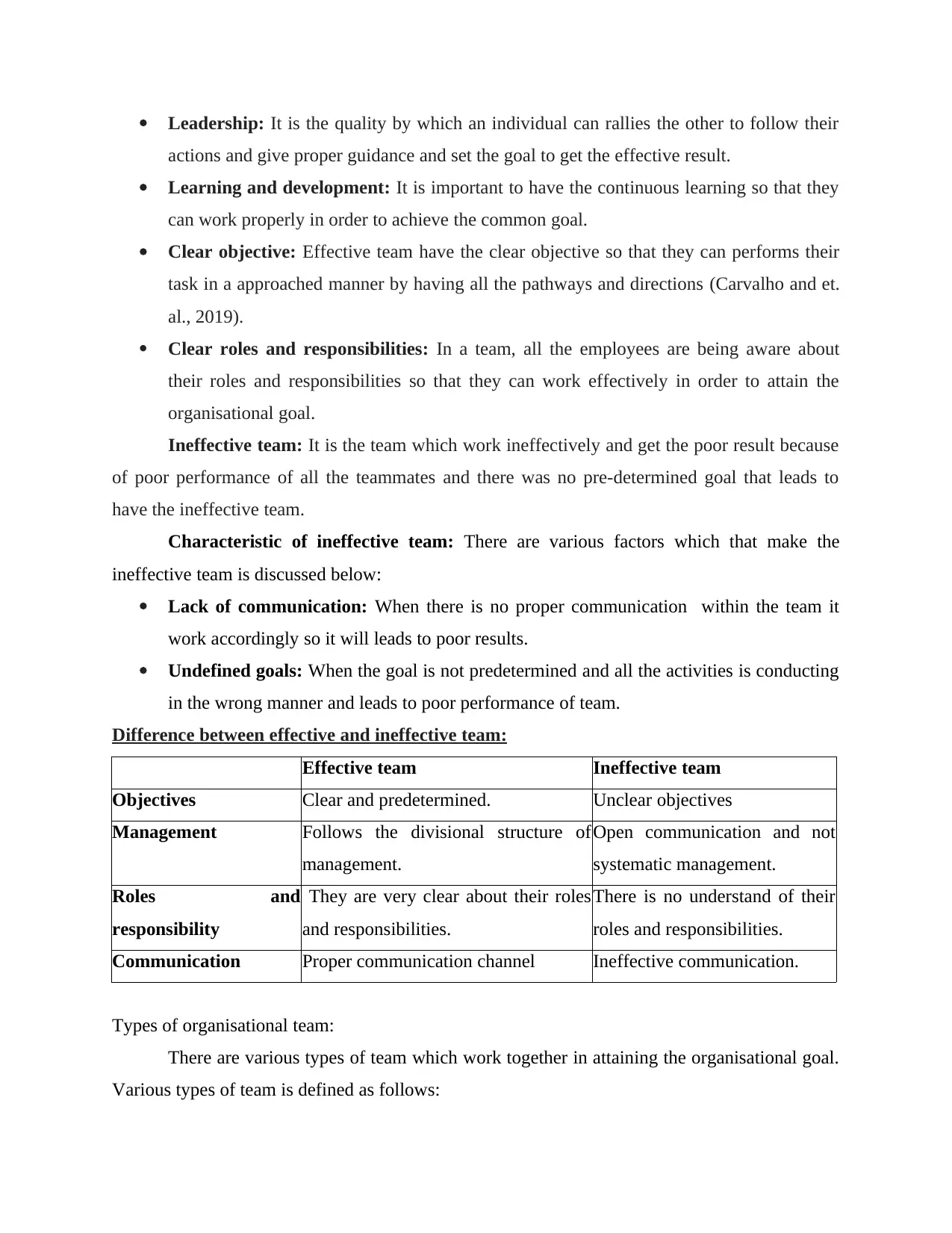
Leadership: It is the quality by which an individual can rallies the other to follow their
actions and give proper guidance and set the goal to get the effective result.
Learning and development: It is important to have the continuous learning so that they
can work properly in order to achieve the common goal.
Clear objective: Effective team have the clear objective so that they can performs their
task in a approached manner by having all the pathways and directions (Carvalho and et.
al., 2019).
Clear roles and responsibilities: In a team, all the employees are being aware about
their roles and responsibilities so that they can work effectively in order to attain the
organisational goal.
Ineffective team: It is the team which work ineffectively and get the poor result because
of poor performance of all the teammates and there was no pre-determined goal that leads to
have the ineffective team.
Characteristic of ineffective team: There are various factors which that make the
ineffective team is discussed below:
Lack of communication: When there is no proper communication within the team it
work accordingly so it will leads to poor results.
Undefined goals: When the goal is not predetermined and all the activities is conducting
in the wrong manner and leads to poor performance of team.
Difference between effective and ineffective team:
Effective team Ineffective team
Objectives Clear and predetermined. Unclear objectives
Management Follows the divisional structure of
management.
Open communication and not
systematic management.
Roles and
responsibility
They are very clear about their roles
and responsibilities.
There is no understand of their
roles and responsibilities.
Communication Proper communication channel Ineffective communication.
Types of organisational team:
There are various types of team which work together in attaining the organisational goal.
Various types of team is defined as follows:
actions and give proper guidance and set the goal to get the effective result.
Learning and development: It is important to have the continuous learning so that they
can work properly in order to achieve the common goal.
Clear objective: Effective team have the clear objective so that they can performs their
task in a approached manner by having all the pathways and directions (Carvalho and et.
al., 2019).
Clear roles and responsibilities: In a team, all the employees are being aware about
their roles and responsibilities so that they can work effectively in order to attain the
organisational goal.
Ineffective team: It is the team which work ineffectively and get the poor result because
of poor performance of all the teammates and there was no pre-determined goal that leads to
have the ineffective team.
Characteristic of ineffective team: There are various factors which that make the
ineffective team is discussed below:
Lack of communication: When there is no proper communication within the team it
work accordingly so it will leads to poor results.
Undefined goals: When the goal is not predetermined and all the activities is conducting
in the wrong manner and leads to poor performance of team.
Difference between effective and ineffective team:
Effective team Ineffective team
Objectives Clear and predetermined. Unclear objectives
Management Follows the divisional structure of
management.
Open communication and not
systematic management.
Roles and
responsibility
They are very clear about their roles
and responsibilities.
There is no understand of their
roles and responsibilities.
Communication Proper communication channel Ineffective communication.
Types of organisational team:
There are various types of team which work together in attaining the organisational goal.
Various types of team is defined as follows:
Paraphrase This Document
Need a fresh take? Get an instant paraphrase of this document with our AI Paraphraser
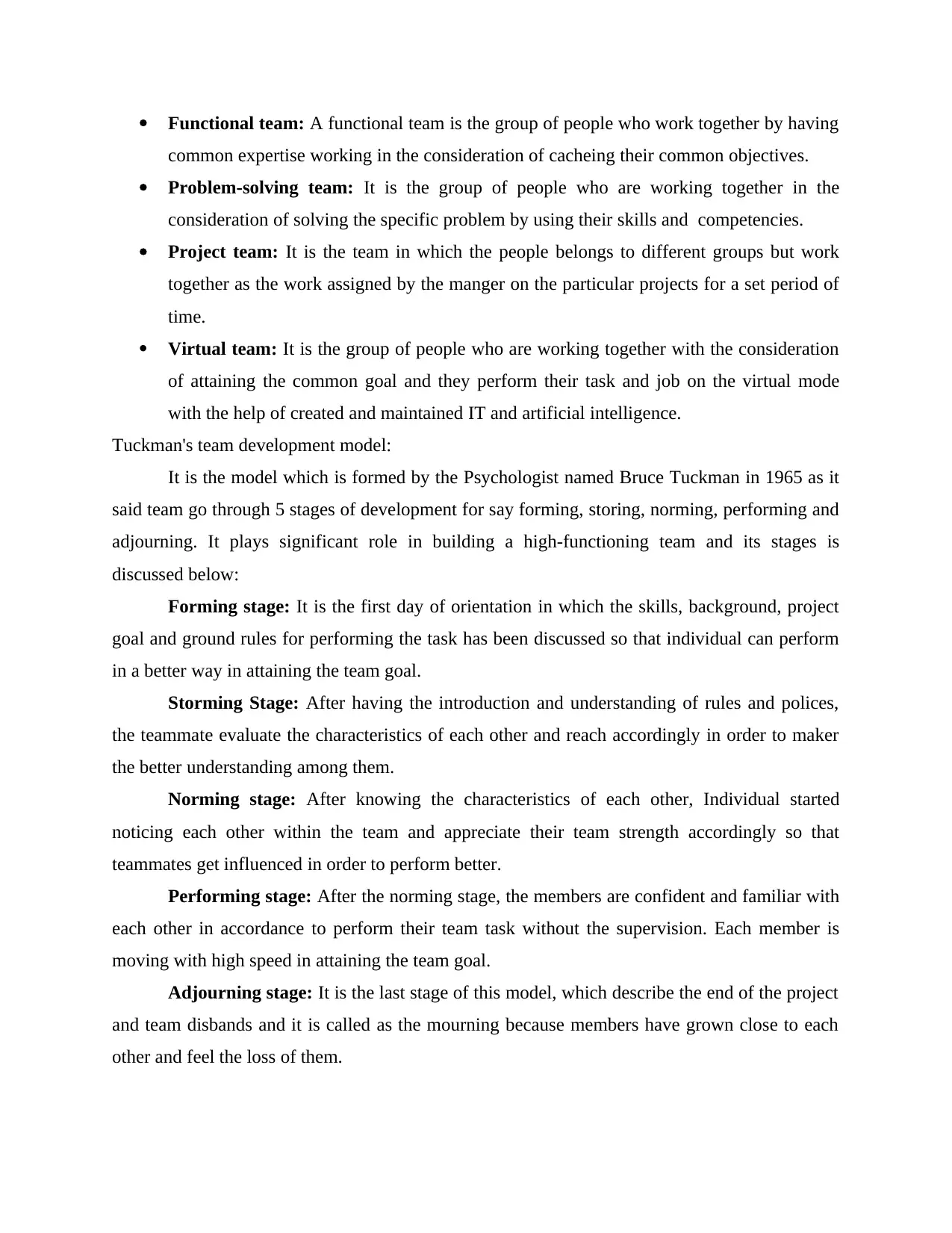
Functional team: A functional team is the group of people who work together by having
common expertise working in the consideration of cacheing their common objectives.
Problem-solving team: It is the group of people who are working together in the
consideration of solving the specific problem by using their skills and competencies.
Project team: It is the team in which the people belongs to different groups but work
together as the work assigned by the manger on the particular projects for a set period of
time.
Virtual team: It is the group of people who are working together with the consideration
of attaining the common goal and they perform their task and job on the virtual mode
with the help of created and maintained IT and artificial intelligence.
Tuckman's team development model:
It is the model which is formed by the Psychologist named Bruce Tuckman in 1965 as it
said team go through 5 stages of development for say forming, storing, norming, performing and
adjourning. It plays significant role in building a high-functioning team and its stages is
discussed below:
Forming stage: It is the first day of orientation in which the skills, background, project
goal and ground rules for performing the task has been discussed so that individual can perform
in a better way in attaining the team goal.
Storming Stage: After having the introduction and understanding of rules and polices,
the teammate evaluate the characteristics of each other and reach accordingly in order to maker
the better understanding among them.
Norming stage: After knowing the characteristics of each other, Individual started
noticing each other within the team and appreciate their team strength accordingly so that
teammates get influenced in order to perform better.
Performing stage: After the norming stage, the members are confident and familiar with
each other in accordance to perform their team task without the supervision. Each member is
moving with high speed in attaining the team goal.
Adjourning stage: It is the last stage of this model, which describe the end of the project
and team disbands and it is called as the mourning because members have grown close to each
other and feel the loss of them.
common expertise working in the consideration of cacheing their common objectives.
Problem-solving team: It is the group of people who are working together in the
consideration of solving the specific problem by using their skills and competencies.
Project team: It is the team in which the people belongs to different groups but work
together as the work assigned by the manger on the particular projects for a set period of
time.
Virtual team: It is the group of people who are working together with the consideration
of attaining the common goal and they perform their task and job on the virtual mode
with the help of created and maintained IT and artificial intelligence.
Tuckman's team development model:
It is the model which is formed by the Psychologist named Bruce Tuckman in 1965 as it
said team go through 5 stages of development for say forming, storing, norming, performing and
adjourning. It plays significant role in building a high-functioning team and its stages is
discussed below:
Forming stage: It is the first day of orientation in which the skills, background, project
goal and ground rules for performing the task has been discussed so that individual can perform
in a better way in attaining the team goal.
Storming Stage: After having the introduction and understanding of rules and polices,
the teammate evaluate the characteristics of each other and reach accordingly in order to maker
the better understanding among them.
Norming stage: After knowing the characteristics of each other, Individual started
noticing each other within the team and appreciate their team strength accordingly so that
teammates get influenced in order to perform better.
Performing stage: After the norming stage, the members are confident and familiar with
each other in accordance to perform their team task without the supervision. Each member is
moving with high speed in attaining the team goal.
Adjourning stage: It is the last stage of this model, which describe the end of the project
and team disbands and it is called as the mourning because members have grown close to each
other and feel the loss of them.
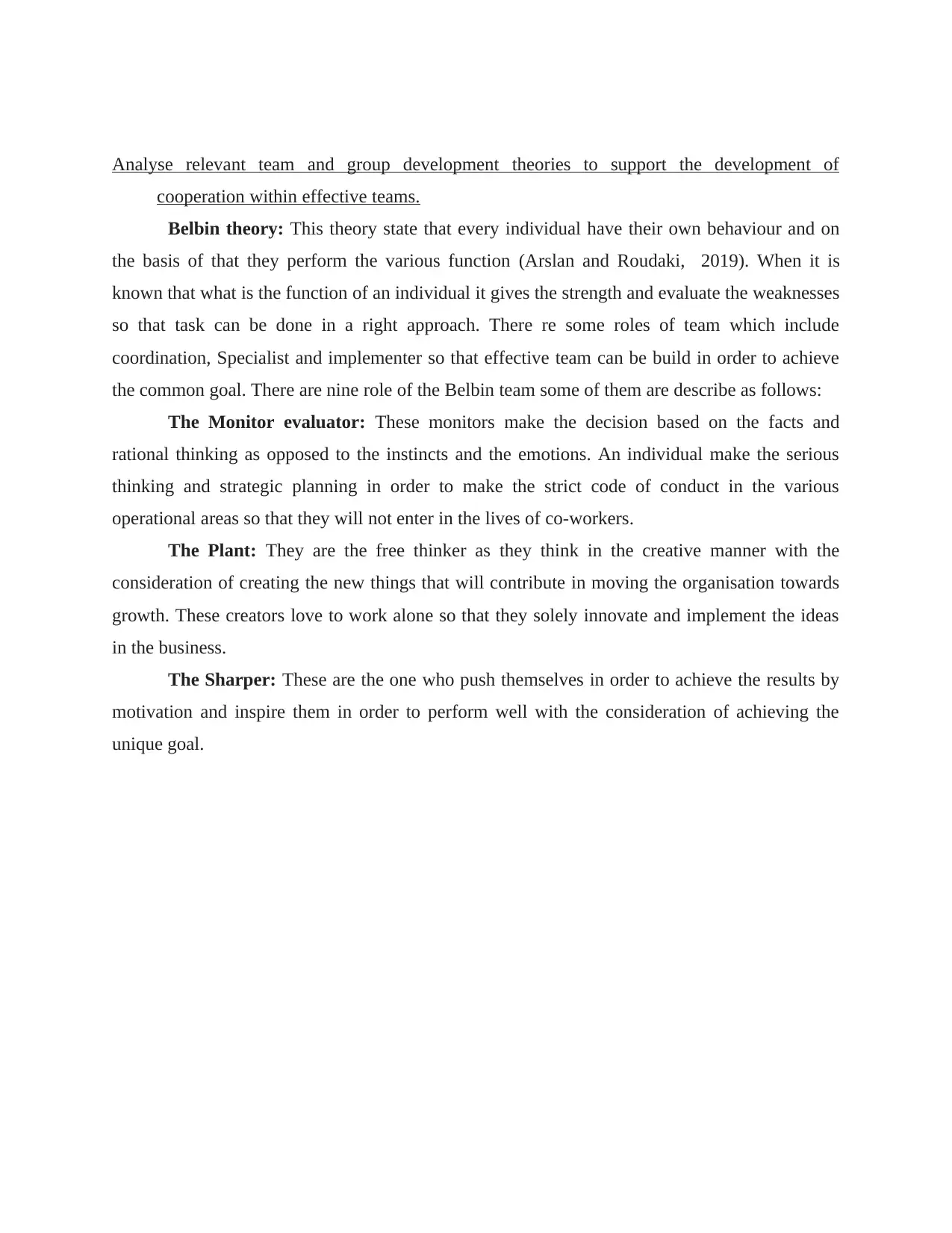
Analyse relevant team and group development theories to support the development of
cooperation within effective teams.
Belbin theory: This theory state that every individual have their own behaviour and on
the basis of that they perform the various function (Arslan and Roudaki, 2019). When it is
known that what is the function of an individual it gives the strength and evaluate the weaknesses
so that task can be done in a right approach. There re some roles of team which include
coordination, Specialist and implementer so that effective team can be build in order to achieve
the common goal. There are nine role of the Belbin team some of them are describe as follows:
The Monitor evaluator: These monitors make the decision based on the facts and
rational thinking as opposed to the instincts and the emotions. An individual make the serious
thinking and strategic planning in order to make the strict code of conduct in the various
operational areas so that they will not enter in the lives of co-workers.
The Plant: They are the free thinker as they think in the creative manner with the
consideration of creating the new things that will contribute in moving the organisation towards
growth. These creators love to work alone so that they solely innovate and implement the ideas
in the business.
The Sharper: These are the one who push themselves in order to achieve the results by
motivation and inspire them in order to perform well with the consideration of achieving the
unique goal.
cooperation within effective teams.
Belbin theory: This theory state that every individual have their own behaviour and on
the basis of that they perform the various function (Arslan and Roudaki, 2019). When it is
known that what is the function of an individual it gives the strength and evaluate the weaknesses
so that task can be done in a right approach. There re some roles of team which include
coordination, Specialist and implementer so that effective team can be build in order to achieve
the common goal. There are nine role of the Belbin team some of them are describe as follows:
The Monitor evaluator: These monitors make the decision based on the facts and
rational thinking as opposed to the instincts and the emotions. An individual make the serious
thinking and strategic planning in order to make the strict code of conduct in the various
operational areas so that they will not enter in the lives of co-workers.
The Plant: They are the free thinker as they think in the creative manner with the
consideration of creating the new things that will contribute in moving the organisation towards
growth. These creators love to work alone so that they solely innovate and implement the ideas
in the business.
The Sharper: These are the one who push themselves in order to achieve the results by
motivation and inspire them in order to perform well with the consideration of achieving the
unique goal.
⊘ This is a preview!⊘
Do you want full access?
Subscribe today to unlock all pages.

Trusted by 1+ million students worldwide
1 out of 17
Related Documents
Your All-in-One AI-Powered Toolkit for Academic Success.
+13062052269
info@desklib.com
Available 24*7 on WhatsApp / Email
![[object Object]](/_next/static/media/star-bottom.7253800d.svg)
Unlock your academic potential
Copyright © 2020–2025 A2Z Services. All Rights Reserved. Developed and managed by ZUCOL.



